S19-Wk1 : "Introduction to basic electronics"
Assalam O Alaikum |
|---|
Hello dear friends! Well come to my post. How are you all? I hope you will be doing well by the grace of Almighty Allah. I'm also fine and enjoying my day. Today I'm here to participate in first lesson of Electrons Eagle's Team in this Electronics Academy. The topic of this lesson is "Introduction to Basic Electronics". So let's start without any more delay of time.
Workshop 1; Electronic Symbology |
|---|
Dear friends as we all know that the electronic symbology is a pictographic way of representing different electronic devices and their functions. That kind of symbols also used in electrical circuits to provide us a quick information about the components which are used in a circuit including the capacitors, resistors, diodes and transistors etc. Through understanding these symbols we can understand that what is happening within that circuit and what kind of electrical component are used in it.
In most of the cases these electrical symbols are standard which means that same types one symbols are used worldwide based on the electric components which are used in that circuit. But also these symbols may be different in different countries of the world as people are updating with the passage of time so there is a possibility that you can find different types of these symbols. As in the first workshop we have to learn about these symbols.
So to understand these symbols, I have drawn them on a page as it is the part of first workshop which you can see in the below picture.
Here are the symbols of alternating current, direct current, ampere, resistance, potentiometer, rectifier diode, zener diode, LED diode, diode bridge, electrolytic capacitor, ceramic capacitor, coil, fuse, battery, transformer, motor, ground npn and pnp.
Workshop 2; Briefly Define followings |
|---|
1. Alternating Voltage:
- Alternating Voltages can be defined as the electrical voltages which change their directions periodically as they can be found in multi directions. The direct voltages (DC voltages) flow only in single direction but the alternating voltages can flow in different directions. That is why they are used to provide electricity to industries and to houses in a wide range.
2. Direct Voltage:
- The electrical voltages which flows in a single direction are known as direct voltages. They don't change their directions over the time and that type of voltages can be generated from solar panels, batteries and from other DC residences. Also they have constant power supply and can't move to the long distance like AC voltages.
3. Resistance:
- The opposing force that affects the flow of charges within a wire by the conductors, it is called as resistance. Resistance is the characteristics of particular wire and also it depends on the dimensions, length, width and temperature of conductors. When the resistance is high the flow of charges may slows down.
4. Potentiometer:
- The potentiometer is an electrical device which is used to measure and compare the potential difference between two points without drawing any current from original circuit. Besides this it is used as a potential divider, to measure emf of cell and internal resistance of the cell also. It is consists of a resistor in the form of wire which can slide.
5. Rectifier Diode:
- The rectifier diode can be defined as a semiconductor device which is used to covert the alternating current into direct current to make it to flow in a single direction. In this way it plays a vital role in creating Direct DC power resources with the help of AC inputs and make the current to flow in a single direction.
6. Diode Bridge:
- Diode bridge is consists of four rectifier diodes arranged in a circuit and it is perform the same function which the rectifier diode perform or converting the alternating current into direct current. In the large circuits it plays a vital role of providing rectified current to the domestic circuits.
7. Capacitor:
- The capacitors are very important part of circuits as they play a vital role in storing and releasing electrical energy within a circuit. They are designed to control the smooth flow of current by storing it and releasing it over the specific interval of time. In this way we can say that it controls the fluctuations of electrical current.
8. Transistor:
- The transistors are the digital semiconductors which are designed to switch the electrical voltages and electrical shingles in different devices such as in radios, amplifiers and and in many other devices of that era. In this way we can say that they can control the flow of current in these devices.
9. Transformer:
- The transformer is an electrical device which is used to transfer electrical energy across different alternating current sources through electromagnetic induction. The electricity we are using in our houses are coming to these transformers. The transformers can be found in different types such as step up transformer, step down transformer and isolated transformer.
10. Fuse:
- The fuse is an electrical device which is used to prevent short circuits and over currents. It is acts as a protective device as when the short circuit happens blocks the supply of current through the wires and prevents us from damage. Due to these advantages they have become a very integral part of our circuits.
11. Lithium Battery:
- The batteries which are consists of lithium ions to generate power are known as lithium batteries. These are the rechargable batteries which used anode and cathodes in generating power due to that reason they are known as one of the best power suppliers as they have a long life span.
Workshop 3; Mention the types of followings |
|---|
1. Resistors:
- Variable Resistors
- Linear Resistors
- Non Variable Resistors
- Fixed Resistors
2. Capacitors:
- Variable Capacitors
- Film Capacitor
- Ceramic Capacitor
- Mica Capacitor
- Tantalum Capacitor
3. Diodes:
- Laser Diode
- Zener Diode
- Photodiode
- Pn Junction Diode
- Rectifier Diode
4. Transistor:
- Surface mount Transistor
- Through hole transistor
- Power module Transistor
- Fixed Transistor
5. Coils:
- Copper Coil
- Hormone coil
- Solenoid Coils
- Inductors
Workshop 4; Identification of electronic components |
|---|
Actually in that circuit, different types of electrical components are used including the transformers, Inductors, capacitors and fuses etc. To make it easily understandable I have marked them with different colored arrows. So let's discuss more deeper about them.
1. Capacitors:
- The components labeled with pink colored arrow are the capacitors and also they have blue metallic labelled. They are in cylindrical shape and many in Quantico.
2. Transformer:
- The component wrapped with yellow colored tape is the transformer and in the above picture you can see it is marked with a silver colored arrow. It transfer power to that circuit.
3. Inductors:
- The component which has copper winding and a black colored body is the indicators and you can see in the above picture it is marked with a red arrow. They store energy in a circuit.
4. Resistors:
- In that circuit the components which have color bands on them are the resistors. I think they are present in green and red color as they are very small it looking difficult for me to recognize.
5. Input socket:
- The component which is present at the top of the left side is the power input socket. It is black in color which as in it the external power supply is connected.
6. Wire gauze:
- The white colored components marked with green arrow is likely a ware gauze as you can on it different types of wires are connected.
7. Connectors:
- The white colored components present at the top of the circuit are connectors which connects the different components of circuit together.
8. Fuse:
- The small cylindrical component present near the power input socket are the fuse which protect the short circuit And other things.
1. Integrated Circuit:
- The black device which you can see that circuit marked by blue arrow is the integrated Circuit which plays a vital role in the generation of power as it is consists of several small components.
2. Surface mount Resistors:
- The components which is marked by black arrow is known as the surface mount resistors and in that circuit they are present in a large quantity.
3. PCB Markings:
- The components which are mentioned with the red arrow are the PCB Markings which tell us about the different symbols of duty different composed.
So friends that was the answers about the first lesson of the topic and I hope these answers will correct. And now it is a time to say goodbye to everyone and I want to invite my friends @wakeupkitty, @josepha, @steemdoctor1 and @jiya99 to take a part in this amazing challenge.
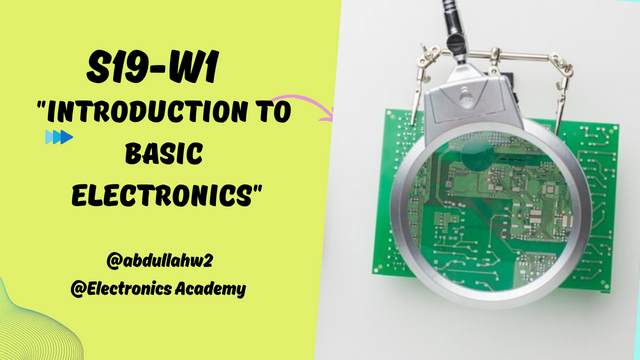
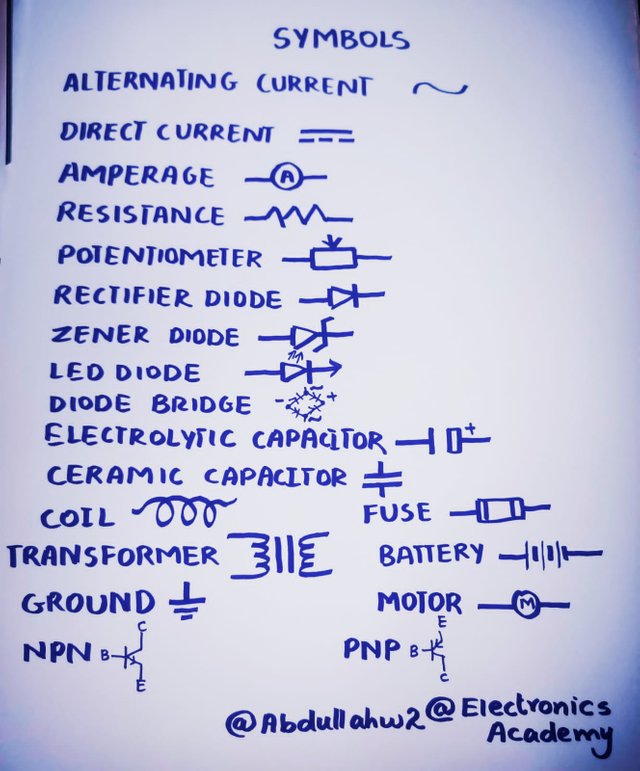
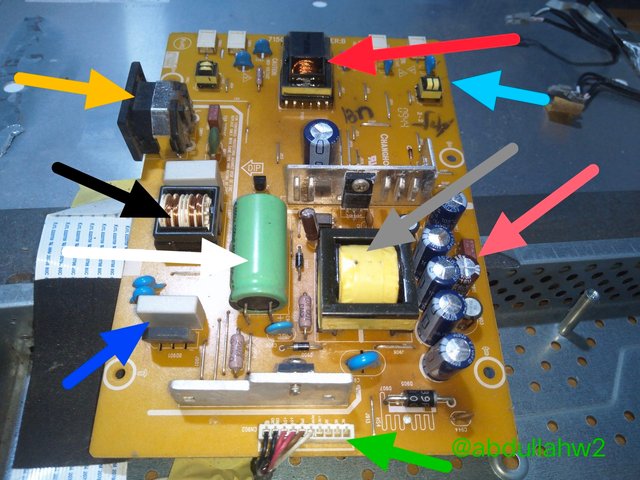
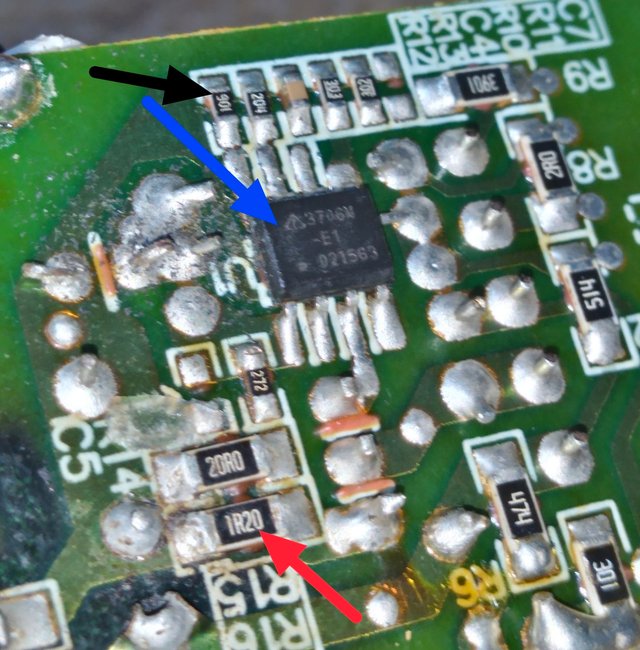

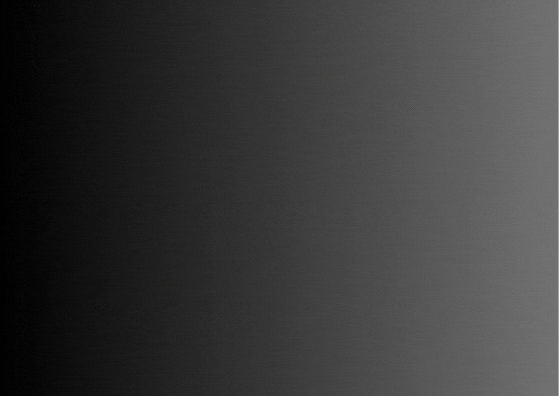
Thank you, friend!


I'm @steem.history, who is steem witness.
Thank you for witnessvoting for me.
please click it!
(Go to https://steemit.com/~witnesses and type fbslo at the bottom of the page)
The weight is reduced because of the lack of Voting Power. If you vote for me as a witness, you can get my little vote.
Upvoted. Thank You for sending some of your rewards to @null. It will make Steem stronger.
You have done a great job here. Knowing the components parts of electronic is very important. I wish you good luck.
Thank you so much dear friend for a lovely comment ❤️
Assalam-Alaikum brother
Hopefully that you will be doing well with the blessings of Almighty Allah. I have read your post, truly it's very informative about basic electronics. Your drawing is so beautiful and also you have beautifuly identify all the circuits. Overall excellent post, wishing you best of luck for contest.
وعلیکم السلام ورحمتہ اللہ! Yes Alhamdulillah bro I'm fine and I'm glad to hear that you liked my entry and also it was helpful for you. Thank you so much for your precious time. stay blessed 👍